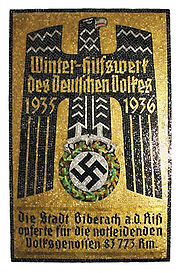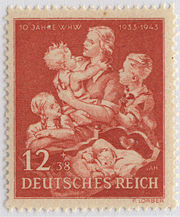
Winterhilfswerk
Encyclopedia


Heinrich Brüning
Heinrich Brüning was Chancellor of Germany from 1930 to 1932, during the Weimar Republic. He was the longest serving Chancellor of the Weimar Republic, and remains a controversial figure in German politics....
in 1931, though Hitler would later claim sole credit. It ran from 1933-1945 during the months of October through March, and was designed to provide food, clothing, coal, and other items to less fortunate Germans during the inclement months.
As part of the centralization of Nazi Germany, posters urged people to donate rather to give directly to beggars.
The Hitlerjugend and Bund Deutscher Mädel (boys' and girls' associations, respectively) were extremely active in collecting for this charity. As part of the effort to place the community
Volksgemeinschaft
Volksgemeinschaft is a German expression meaning "people's community". Originally appearing during World War I as Germans rallied behind the war, it derived its popularity as a means to break down elitism and class divides...
over the individual, totals were not reported for any individuals, only what the branch raised.
Certain weekends were assigned to all of the different Nazi associations, each with their own special Abzeichen to pass out in exchange for a pfennig or two. These highly collectible items were made of many different materials , such as wood, glass, paper, terra cotta, metal , and plastic. Over 8000 different pieces were produced by war's end, and some of the rarer ones sell for quite a lot of money today.
The "Can Rattlers", as they became known, were relentless in their pursuit of making sure every good German citizen gave their share to the WHW. In fact those who "forgot" to give had their names put in the paper to remind them of their neglect. Neighbors, and even family members were encouraged to whisper the names of shirkers to their block leaders so that they could persuade them to do their duty. On one occasion, a civil servant was prosecuted for failure to donate, and his argument that it was voluntary was dismissed on the grounds it was an extreme view of liberty, to neglect all duties not actually prescribed by law, and therefore an abuse of liberty.
Large donations were also a means to establish oneself as a loyal supporter of the Nazi Party without the commitment of joining it.
A greatly encouraged practice was to, once a month, have a one-pot meal, reducing all the food to one course; the money thus saved was to be donated.
Collection drives were a mainstay of the Winter Relief, and those who did not give, or gave little (such as one pair of boots to a clothing drive), were sometimes the victims of mob violence and needed to be protected by the police.
A paper Monatsturplaketten (monthly placard) was issued to place on your door or in your window to show others that you had given, and also to keep the roaming bands of charity workers at bay.
Donors were often given small souvenir gratitude gifts of negligible value, somewhat similar to the way modern charities mail out address labels and holiday cards. A typical such gift was a very small propaganda booklet, reminiscent of Victorian-era miniature books; about 0.8" wide x 1.5" tall. Booklets included The Führer Makes History, a collection of Hitler photographs, The Führer’s Battle in the East 2, and Gerhard Koeppen and other decorated heroes of the war.
More generous donors would receive concomitantly better gifts, such as lapel pins on a wide variety of themes. Some depicting occupational types or geographic areas of the Reich, others animals, birds and insects, nursery rhyme and fairy tale characters, or notable persons from German history (including of course Adolf Hitler himself). They were made from a variety of materials. Each individual miniature book, badge, badge set or toy set was only available for two or three days of a particular collection drive. So the populace would be encouraged to donate the following week and thereby collect the latest in the series. There could also be very annoying consequences; nagging by the appropriate official if your local Blockleiter saw that you were not wearing the current, appropriate pin by about Tuesday of the week.
When he visited Germany in 1939 as a reporter for the North American Newspaper Alliance, Dr. Lothrop Stoddard
Lothrop Stoddard
Theodore Lothrop Stoddard was an American historian, journalist, racial anthropologist, eugenicist, political theorist and anti-immigration advocate who wrote a number of books which are cited by historians as prominent examples of early 20th-century scientific racism.- Biography :Stoddard was...
wrote:
"...Once a fortnight, every city, town, and village in the Reich seethes with brown-shirted Storm Troopers carrying red-painted canisters. These are the Winter-Help collection-boxes. The Brown-Shirts go everywhere. You cannot sit in a restaurant or beer-hall but what, sooner or later, a pair of them will work through the place, rattling their canisters ostentatiously in the faces of customers. And I never saw a German formally refuse to drop in his mite, even though the contribution might have been less than the equivalent of one American cent.
"During these periodic money-raising campaigns, all sorts of dodges are employed. On busy street-corners comedians, singers, musicians, sailors, gather a crowd by some amusing skit, at the close of which the Brown-Shirts collect. People buy tiny badges to show they have contributed—badges good only for that particular campaign. One time they may be an artificial flower; next time a miniature dagger, and so forth. The Winter-Help campaign series reaches its climax shortly before Christmas in the so-called Day of National Solidarity. On that notable occasion the Big Guns of the Nazi Party sally forth with their collection-boxes to do their bit."
Taken as a whole, the WHW program was a brilliant propaganda coup for Hitler and the Nazis. Not only did it serve to break down all the class barriers of society, it also helped solidify Hitler's bond to the people. Indeed most of the early slogans called for citizens to join Hitler in the struggle to protect the Mutter und Kind, the family, and to help him provide freedom and bread to every German house.
The collection drives of 1933 to 1945 issued a large number of themed ceramic medallions and other badges given to donators.

